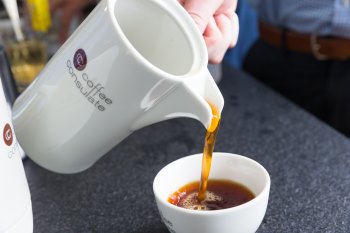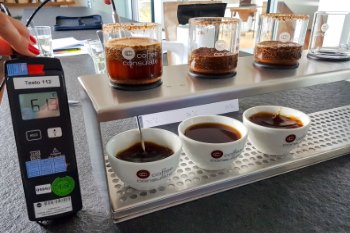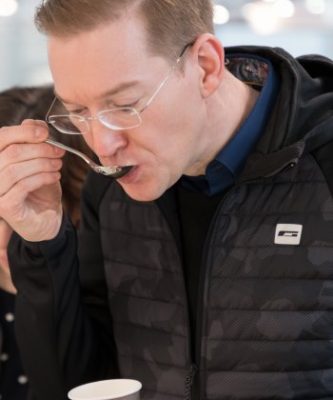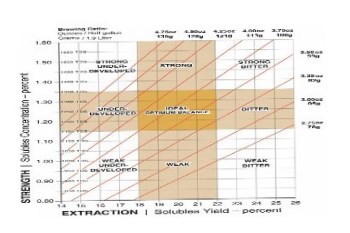Some Like It Too Hot? Rethinking Coffee Serving Practices
When questioning professionals or consumers about influences on coffee quality, factors such as type, variety and origin, processing, sorting, gentle roasting, fresh grinding or the type of preparation are usually named. Very rarely, however, is the temperature is brought into play. According to popular opinion, the best way to think with coffee is “the hotter the better“. This belief needs to be tackled in two ways.

On the one hand, brewing and drinking temperatures have a considerable influence on the sensory quality of the beverage. Brewing should by no means take place at temperatures higher than 92 °C, since above this temperature undesirable bitter and astringent substances clearly dominate the flavour profile. On the other hand, below 70 °C brewing temperature, the cup is dramatically flat and watery, as fat-soluble substances and aromas are significantly reduced in particular. The optimum brewing temperature thus usually falls into the range of 85-92 °C, also dependent on other parameters such as machine type, pressure, and percolation time.
 According to current own research results of more than 300 temperature measurements in gastronomy in southern Germany, the coffee-serving temperature is around 70-80 °C (average 75 °C). This temperature is considered to be very high and significant cooling is required to achieve a satisfying taste experience. In an orienting cup tasting, we tasted an identically brewed coffee at 62 °C, 54 °C and 45 °C. At the highest temperature the taste was not even noticeable (at this temperature range, the feedback of pain receptors appears to completely overlay the one of the taste buds). At 54 °C, the coffee was much more acidic and fruity. The best flavour profile was described at the lowest temperature, with pronounced acidity and sweetness and a pronounced body, a dramatic difference from the highest temperature.
According to current own research results of more than 300 temperature measurements in gastronomy in southern Germany, the coffee-serving temperature is around 70-80 °C (average 75 °C). This temperature is considered to be very high and significant cooling is required to achieve a satisfying taste experience. In an orienting cup tasting, we tasted an identically brewed coffee at 62 °C, 54 °C and 45 °C. At the highest temperature the taste was not even noticeable (at this temperature range, the feedback of pain receptors appears to completely overlay the one of the taste buds). At 54 °C, the coffee was much more acidic and fruity. The best flavour profile was described at the lowest temperature, with pronounced acidity and sweetness and a pronounced body, a dramatic difference from the highest temperature.

The reason for this observation is the fact that in a cupping at 45 ° C, the coffee in the oral cavity will be around the same as our body temperature. Above fever temperatures (42 °C), pain reactions and irritation of the oral mucosa due to protein denaturation cannot be ruled out. For the same reason, i.e. in order to avoid protein denaturation, the temperature for cappuccino preparation should also be mafr lower than what is common practice. In particular, the creaminess and elasticity of a perfect milk foam cannot be achieved at the usual temperatures in gastronomy, which are much too high. The result is an empty “bath foam”, which lacks any creaminess.

These considerations already show that too high drinking temperatures also have an effect on the human body. In fact, studies from countries where drinks are consumed very hot (such as tea in Iran or mate in South America) have shown that this drinking behaviour significantly increases the risk of developing esophageal cancer. The International Agency for Research on Cancer (IARC) of the World Health Organization (WHO) has classified “very hot” beverages as “probably carcinogenic to humans” on the basis of epidemiological investigations worldwide. As threshold for “very hot”, the IARC indicates a temperature of 65 °C. Thus, the above-mentioned serving temperature of coffee in Germany (75 °C) is above this threshold for probable carcinogenicity.

For both reasons (improved taste quality, exclusion of a cancer risk) coffee should therefore be consumed at lower temperatures than what is currently the case. For this purpose, a paradigm shift in gastronomy and consumers must be made towards “the hotter the worse”. As a first measure, the machine output temperature could be limited at below 80 °C. The serving temperature should be below 70 °C so that the consumption temperature is usually below the IARC threshold of 65 °C.
Then the barista can also present his coffee expertise with a special taste experience and also serve a perfect cappuccino, which is remembered not only for thermal off-flavours.
S. Schwarz, D. W. Lachenmeier. Kaffee. Lieber weniger heiß? Food Service, 2017(12), p. 12.


